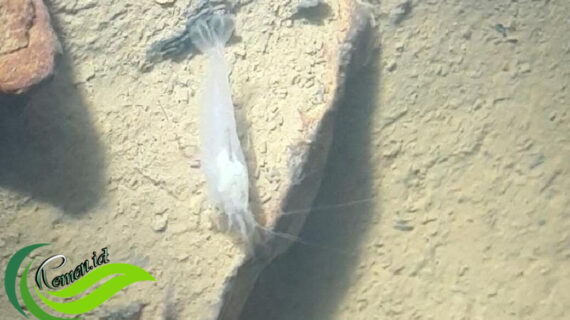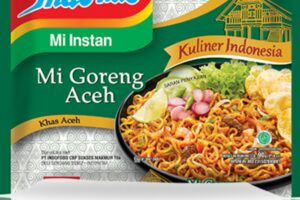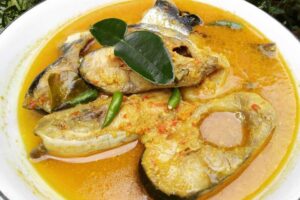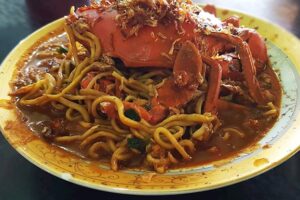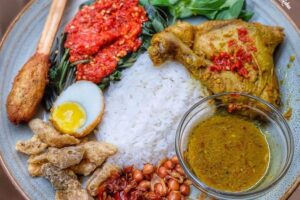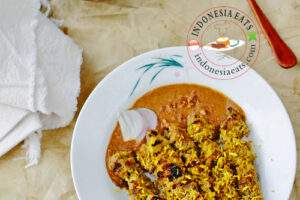Papua, located in eastern Indonesia, is a region renowned for its rich cultural heritage and unique culinary traditions. The local cuisine reflects the area’s deep connection to nature, with an emphasis on fresh, locally sourced ingredients and traditional cooking methods. From the famous “udang selingkuh” (a type of freshwater crustacean) to the staple “papeda” made from sago, Papua’s food culture offers a vibrant and diverse experience that is both flavorful and deeply rooted in tradition.
This article explores some of the most iconic and delicious foods that define the culinary identity of Papua, highlighting their origins, preparation methods, and significance in local culture.
1. Udang Selingkuh – The Unique Freshwater Crustacean
One of the most distinctive dishes in Papua is “Udang Selingkuh,” a freshwater crustacean known for its lobster-like texture and sweet taste. Despite its name, which translates to “cheating shrimp,” this creature is not a true shrimp but more closely related to crayfish or freshwater lobsters. Found primarily in the Baliem River in Jayawijaya Regency, Udang Selingkuh has a firm, fibrous texture and a delicate sweetness that sets it apart from other seafood.
The dish can be prepared in various ways, such as frying, boiling, or stir-frying with sauces like oyster or Padang sauce. It is often served with papaya flowers or kangkung (water spinach), making it a popular choice among locals and visitors alike.
2. Papeda – The Staple of Papuan Cuisine

Papeda is one of the most iconic dishes in Papua, serving as a staple food for many communities. Made from sago flour, papeda has a thick, sticky consistency and a neutral flavor. Traditionally eaten with “ikan kuah kuning” (yellow fish soup), papeda is a vital part of daily meals and is often consumed without chewing, as it can stick to teeth if not swallowed quickly.
The preparation involves mixing sago flour with water and cooking it until it becomes a thick, gelatinous paste. This dish is not only a source of carbohydrates but also a symbol of cultural identity for the indigenous people of Papua.
3. Ikan Bakar Manokwari – The Flavorful Grilled Fish
Manokwari, the capital of West Papua, is famous for its grilled fish, particularly “Ikan Bakar Manokwari.” This dish features large mackerel fish marinated in lemon juice and salt before being grilled over an open flame. What makes it unique is the use of a special chili sauce called “dabu-dabu,” which adds a fresh and spicy kick to the dish.
Served with side dishes like rice or papeda, Ikan Bakar Manokwari is a must-try for anyone visiting the region. Its bold flavors and simple yet elegant preparation reflect the essence of Papuan cuisine.
4. Norohombi – A Traditional Sago-Based Snack
Norohombi is a traditional snack made from sago flour, grated coconut, and dried shellfish (bia). The mixture is formed into thin, crispy layers and baked over an open fire. This dish is not only a source of nutrition but also a reflection of the resourcefulness of the Papuan people in utilizing available ingredients.
Its crunchy texture and savory flavor make it a popular choice for snacks and gatherings. Norohombi is often enjoyed with tea or coffee, adding a comforting touch to any meal.
5. Kue Sagu – The Crunchy Sago Cake
Kue Sagu, also known as Bagea, is a traditional cake made from sago flour. Unlike regular cakes, Kue Sagu has a hard, dense texture that softens once it reaches the mouth. This unique quality makes it a favorite among those who enjoy a contrast between crunch and softness.
It is commonly served during festivals and special occasions, especially in Central Papua. The cake is often accompanied by a cup of sweet tea, enhancing the overall dining experience.
6. Aunu Senebre – The Steamed Fish and Rice Dish
Aunu Senebre is a traditional dish that combines steamed rice, small fish (teri), and taro leaves. The rice and fish are fried together and then mixed with grated coconut and taro leaves before being steamed. This dish is a staple in many households and is often served with papeda.
Its combination of textures and flavors makes it a satisfying and nutritious meal, showcasing the ingenuity of Papuan cooking.
7. Eurimoo – The Sweet Sago Ball
Eurimoo is a traditional dessert made from a mix of sago flour and bananas. The mixture is shaped into small balls and boiled until they float. Once cooked, they are topped with grated coconut and salt, giving them a slightly salty and sweet flavor.
This dish is a favorite among children and adults alike, offering a delightful blend of textures and tastes that reflect the simplicity and richness of Papuan cuisine.
8. Sinole – The Sago and Coconut Stuffed Dish
Sinole is a traditional dish made from sago and grated coconut, often referred to as the “sago kebab” due to its resemblance to Middle Eastern kebabs. The filling is typically made with palm sugar, creating a sweet and chewy texture that contrasts beautifully with the sago base.
This dish is a popular choice for celebrations and special occasions, symbolizing the cultural richness of Papua.
9. Aunuve Habre – The Taro-Wrapped Fish Dish
Aunuve Habre is similar to Aunu Senebre but uses a different type of fish—cakalang (mackerel). The fish is wrapped in taro leaves and cooked, resulting in a dish that is both flavorful and aromatic. Unlike Aunu Senebre, it does not include grated coconut, making it a lighter option.
This dish highlights the versatility of taro in Papuan cuisine and showcases the importance of using locally available ingredients.
10. Keladi Tumbuk – The Mashed Taro Dish
Keladi Tumbuk is a traditional dish made from mashed taro, often served as a side dish with grilled fish or vegetables. It has a smooth, creamy texture and a mild, neutral flavor that pairs well with strong-tasting dishes.
This dish is a staple in the Biak region of Papua and is often enjoyed during family gatherings and festivals. Its simplicity and nutritional value make it a beloved part of the local diet.
In conclusion, the culinary traditions of Papua offer a fascinating glimpse into the region’s rich cultural heritage. From the unique “udang selingkuh” to the hearty “papeda,” each dish tells a story of resilience, creativity, and connection to the land. For those seeking an authentic taste of Indonesia’s easternmost region, exploring these traditional foods is an essential part of the journey. Whether you’re a food enthusiast or simply curious about new flavors, Papua’s cuisine promises an unforgettable experience.

